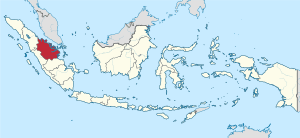Riau facts for kids
Quick facts for kids
Riau
|
|||
|---|---|---|---|
| Other transcription(s) | |||
| • Jawi | رياو | ||
|
From top, right to left: An-Nur Mosque, Muara Takus, Siak Palace, Sunset view in Ulu Kasok and Green riverside of Kampar River, Riau Main Stadium, Tengku Agung Sultanah Latifah bridge, Idrus Tintin The Malay Art Building Center, Cian Cui Festival in Selatpanjang, Sumatran elephant in the Minas Elephant Sanctuary and Tesso Nilo National Park
|
|||
|
|||
| Nickname(s):
Bumi Lancang Kuning (Land of the Glorious)
|
|||
| Motto(s):
بومي برتواه نڬري برادت
Bumi Bertuah Negeri Beradat (Malay) (meaning: Ground of Fortunes, Land of Customs) |
|||

Location of Riau in Indonesia
|
|||
| Country | |||
| Established | 10 August 1957 | ||
| Capital and largest city |
Pekanbaru | ||
| Government | |||
| • Body | Riau Regional Government | ||
| Area | |||
| • Total | 87,023.66 km2 (33,600.02 sq mi) | ||
| Area rank | 7th | ||
| Elevation | 10 m (30 ft) | ||
| Highest elevation | 1,091 m (3,579 ft) | ||
| Lowest elevation | 0 m (0 ft) | ||
| Population
(2017)
|
|||
| • Total | 6,657,900 | ||
| • Rank | 10th | ||
| • Density | 76.5068/km2 (198.1517/sq mi) | ||
| • Density rank | 24th | ||
| Demonym(s) | Riauan Warga Riau (id) Kaum Riau (ms) |
||
| Demographics | |||
| • Ethnic groups | Malay (33.28%), Javanese (29.20%), Batak (12.55%), Minangkabau (12.29%), Chinese (4.13%), others (8.55%) | ||
| • Religion | Islam (89.27%), Protestantism (7.87%), Buddhism (1.84%), Roman Catholicism (1.06%), Confucianism (0.08%), Hinduism (0.07%) | ||
| • Languages | Indonesian (official) Malay, Minangkabau, Hokkien (regional) |
||
| Time zone | UTC+7 (Indonesia Western Time) | ||
| Postcodes |
28xxx, 29xxx
|
||
| Area codes | (62)6xx, (62)76x | ||
| ISO 3166 code | ID-RI | ||
| Vehicle sign | BM | ||
| GRP per capita | US$9,252.17 | ||
| GRP rank | 3rd | ||
| HDI | |||
| HDI rank | 6th (2018) | ||
Riau is a province of Indonesia. It is on the central eastern coast of Sumatra. Its capital city is Pekanbaru. Riau is rich in natural resources. It has petroleum, natural gas, rubber, and palm oil.
History
Riau allegedly has been inhabited since the period between 10,000–40.000 BC. Between 5th to 12th century AD, traders and merchants from the Indian subcontinent visited the region to trade with the local people, spreading Hinduism and Buddhism in the process. Therefore, Riau was under the control of several Hindu-Buddhist kingdoms such as the Melayu Kingdom and the Srivijaya empire. In the 14th century, Muslim traders from India and the Arabian Peninsula visited the region, beginning the spread of Islam in the region. By the end of the 14th century, Hindu and Buddhist influence are waning, while Islam influence are growing, leading to the dissolution of many Hindu-Buddhist Kingdoms in Riau. Those kingdoms who still existed transformed itself into an Islamic Sultanates. By the 16th century, there are three great Malay sultanates in the region, namely the Siak Sri Indrapura Sultanate, Indragiri Sultanates and the Johor Sultanate, the latter which would split in the 19th century into the modern Johor Sultanate in the Malay peninsula and the Riau-Lingga Sultanate in the Riau Archipelago. However, by that time Europeans began frequenting the region. first the Portuguese, then the Dutch and the British.
In 1824, the Dutch and British agreed to divide the sphere of influence in the region, with the Malay peninsula falling under the British and Sumatra falling under the Dutch. Soon afterwards, the power of the sultanates in the region began to wane. The sultanates soon became protectorate of the Dutch and was reduced to nothing but a puppet states of the Dutch East Indies, with the Dutch having the authority to intervene in the everydays affair. This happens until 1942, when the Japanese invaded and occupied Riau during the Pacific theater of World War II. After three years of occupation which was marked by atrocities and war crimes, the Japanese surrendered in 1945. The Dutch soon returned to assume control of the region, but left in 1949 after the Dutch–Indonesian Round Table Conference, in which the Dutch agreed to transfer sovereignty of the Dutch East Indies to the Republic of Indonesia. Since then, Riau has been part of the unitary state of Indonesia.
Images for kids
-
A painting of Riouw, Dutch East Indies, painted between 1859 and 1861
-
Giam Siak Kecil – Bukit Batu biosphere reserves]]Forest cover in Riau has declined from 78% in 1982 to only 33% in 2005. This has been further reduced an average of 160,000 hectares on average per year, leaving 22%, or 2.45 million hectares left as of 2009. Fires associated with deforestation have contributed to serious haze over the province and cities to the East, such as Singapore and Kuala Lumpur, [[Malaysia
-
A traditional Malay wedding replica in Museum Sang Nila Utama, Pekanbaru. Malay forms the majority of the population in Riau.
-
Rumah Melayu Lipat Kajang in Taman Mini Indonesia Indah, Jakarta
-
Gendang (drum) from Riau
-
Sumatran elephants in the Balai Raja Wildlife Reserve
-
Bakar Tongkang or Junk Burning Festival (Chinese: 五月十六日) in Bagansiapiapi, Rokan Hilir, 2019
-
Soeman H.S Library, the largest provincial library in Sumatra
-
Nasi lemak Riau
-
Roti cane with goat curry served in a Riau restaurant
-
Gulai ayam
See also
 In Spanish: Provincia de Riau para niños
In Spanish: Provincia de Riau para niños












































